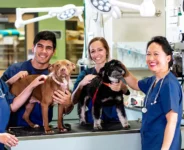
VCA Animal Hospitals opens 3D printing lab
VCA Animal Hospitals, a leader in personalized pet care solutions, is opening a cutting-edge 3D printing lab dedicated to orthopedic surgeries at VCA Northwest Veterinary Specialists in Clackamas, Oregon. This facility aims to revolutionize the treatment of orthopedic conditions in pets by offering customized solutions that enhance recovery and improve quality of life.
Orthopedic conditions such as canine hip dysplasia, elbow dysplasia, and angular limb deformities are common in pets – often leading to pain, arthritis, and mobility issues. Large breeds and younger animals are particularly susceptible. Traditional surgeries for these conditions can be intensive, requiring lengthy recovery periods.
The new 3D printing lab utilizes advanced technology to create precise, custom-fit implants, and surgical guides tailored to each pet’s unique anatomy. This allows for the creation of custom implants designed specifically for each pet to ensure a perfect fit and optimal functionality; surgical guides to improve the accuracy of procedures – reducing the risk of complications and speeding up recovery times; and tailored solutions to promote quicker healing and better long-term outcomes for pets.
VCA Animal Hospitals’ dedicated care teams can conduct simulation surgeries before the actual procedure and produce customized tools and instruments on-site, personalized to each pet’s specific needs. By performing CT scans and creating 3D virtual models, surgeons can 3D print exact replicas of a pet’s anatomy. These models are used during surgery and serve as educational tools for students, interns, care team members, and pet owners.
While the application of 3D printing technology to pet health is novel, it has been recognized in human medicine for years. Tangible anatomical models help surgeons conduct preoperative planning to reduce time in surgery, improve results, and save costs.
Many surgical cases that benefit from these techniques were previously too complicated to perform or had sub-optimal outcomes when done without 3D printing. The ability to understand the three-dimensional anatomy of a bone, which cannot be fully captured with X-rays, enhances surgical planning and execution.



